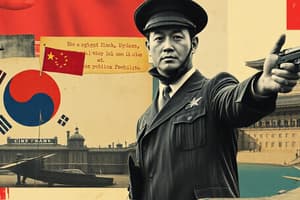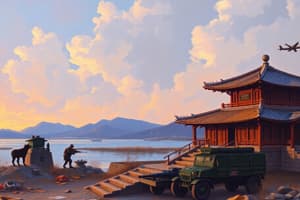Podcast
Questions and Answers
What role did the U.S. Navy play in national security planning between 1945 and 1955?
What role did the U.S. Navy play in national security planning between 1945 and 1955?
- It managed diplomatic relations with European nations.
- It primarily focused on land-based strategies.
- It was largely disregarded in favor of the Air Force.
- It had a significant influence on naval strategies. (correct)
Which publication discusses the influence of naval aviation on strategic thinking?
Which publication discusses the influence of naval aviation on strategic thinking?
- Forces and Strategy: The Air Force and the Strategic Mission, 1945-1950
- The Navy and the Bomb: Naval Aviation's Influence on Strategic Thinking, 1945-1950 (correct)
- The Influence of Naval Strategy On National Security Planning, 1945-1955
- Asian Warm-up to the Cold War
In which era did the U.S. Navy's defense policy evolve significantly?
In which era did the U.S. Navy's defense policy evolve significantly?
- Pre-World War I
- World War II
- Cold War period, 1960-1980
- Postwar years, 1946-1991 (correct)
Which author wrote about the U.S. Navy's defense policy specifically from 1943 to 1946?
Which author wrote about the U.S. Navy's defense policy specifically from 1943 to 1946?
What was a primary focus of the U.S. Navy during the early postwar era?
What was a primary focus of the U.S. Navy during the early postwar era?
What was the main reason for Rusk's choice regarding US forces in Korea?
What was the main reason for Rusk's choice regarding US forces in Korea?
Who was ordered by President Truman to deploy US forces to Korea?
Who was ordered by President Truman to deploy US forces to Korea?
What was Admiral Kinkaid's role during the surrender of Japanese forces in Korea?
What was Admiral Kinkaid's role during the surrender of Japanese forces in Korea?
What task did the Seventh Fleet assist with between 1945 and 1950?
What task did the Seventh Fleet assist with between 1945 and 1950?
Who served as the military governor of South Korea following the surrender?
Who served as the military governor of South Korea following the surrender?
What did naval leaders observe during the postwar period regarding tensions in Korea?
What did naval leaders observe during the postwar period regarding tensions in Korea?
What was the nature of the division of Korea recognized in 1945?
What was the nature of the division of Korea recognized in 1945?
What was a significant observation made during the surrender ceremonies in 1945?
What was a significant observation made during the surrender ceremonies in 1945?
What significant event occurred on September 2, 1945, related to the Korean War?
What significant event occurred on September 2, 1945, related to the Korean War?
By June 1950, how many U.S. battleships were on active duty?
By June 1950, how many U.S. battleships were on active duty?
What was the main concern of President Franklin D. Roosevelt regarding Korea?
What was the main concern of President Franklin D. Roosevelt regarding Korea?
How did the U.S. Navy fleet size change after World War II?
How did the U.S. Navy fleet size change after World War II?
What was determined at the Yalta Conference regarding Korea?
What was determined at the Yalta Conference regarding Korea?
What role did the Soviet Union envision in Korea after the end of Japanese colonial rule?
What role did the Soviet Union envision in Korea after the end of Japanese colonial rule?
What was the size of the U.S. Navy fleet in the Pacific by June 1950?
What was the size of the U.S. Navy fleet in the Pacific by June 1950?
What major consequence resulted from the discussions held at the Cairo and Tehran conferences?
What major consequence resulted from the discussions held at the Cairo and Tehran conferences?
Flashcards
Early Postwar Era
Early Postwar Era
The period following World War II where the United States transitioned to a new national strategy focused on the containment of Communism and the development of nuclear weapons.
Air Force in the Postwar World
Air Force in the Postwar World
The expansion of the Air Force and the shift to nuclear weapons, leading to the U.S. developing a 'strategic mission' with the ability to strike anywhere in the world.
Naval Strategy in the Postwar Era
Naval Strategy in the Postwar Era
A period of Cold War strategy where the United States Navy played a significant role in shaping national security plans, contributing to the development of a strong and capable fleet.
The Navy and the Bomb
The Navy and the Bomb
Signup and view all the flashcards
Cold War
Cold War
Signup and view all the flashcards
End of World War II
End of World War II
Signup and view all the flashcards
Origins of Korean War
Origins of Korean War
Signup and view all the flashcards
Soviet Union's Interest in Korea
Soviet Union's Interest in Korea
Signup and view all the flashcards
US Involvement in Korea
US Involvement in Korea
Signup and view all the flashcards
Allied Conferences
Allied Conferences
Signup and view all the flashcards
Roosevelt's Proposal
Roosevelt's Proposal
Signup and view all the flashcards
Korean War Eruption
Korean War Eruption
Signup and view all the flashcards
38th Parallel
38th Parallel
Signup and view all the flashcards
Division of Korea after WWII
Division of Korea after WWII
Signup and view all the flashcards
Seventh Fleet's Role in Korea
Seventh Fleet's Role in Korea
Signup and view all the flashcards
Temporary US Military Government in South Korea
Temporary US Military Government in South Korea
Signup and view all the flashcards
Repatriation of Japanese Soldiers
Repatriation of Japanese Soldiers
Signup and view all the flashcards
Rising Tensions in Korea
Rising Tensions in Korea
Signup and view all the flashcards
Japanese Surrender: A Complex Process
Japanese Surrender: A Complex Process
Signup and view all the flashcards
US Army establishes a temporary military government in South Korea
US Army establishes a temporary military government in South Korea
Signup and view all the flashcards
US accepts surrender of Japanese forces in Korea
US accepts surrender of Japanese forces in Korea
Signup and view all the flashcards
Study Notes
Origins of the Korean War
- World War II ended with Japan's surrender to Allied forces on September 2, 1945, aboard the USS Missouri.
- The size of the active US Navy drastically decreased from 6,768 ships to 1,248 ships in the months following the war's end.
- The USS Missouri was the only US battleship in active duty during the Korean War, which began in June 1950.
- The Korean War was overshadowed by World War II and the Cold War, but it began before World War II ended, alongside Allied negotiations with Japan.
- The Soviet Union, Japan, and China vied for influence in Korea, with the Soviet Union seeking to expand its regional influence after 35 years of Japanese colonial rule.
- The United States and the Soviet Union divided Korea along the 38th parallel, intended as a temporary boundary, but this division set the stage for future conflict.
- Allied leaders met in conferences (Cairo, Tehran, Yalta, and Potsdam) to strategize for post-war balance and avoid communist rule in Korea.
- President Roosevelt introduced the idea of shared trusteeship of Korea by the Allied powers.
- The Soviet Union joined the war against Japan three months after the end of the European war.
- The atomic bombings of Hiroshima and Nagasaki in August 1945 led to Japan's surrender on August 10, 1945.
- The rapid pace of Japan's surrender led to quick decisions about the division of Korea along the 38th parallel, with little consideration for the local economy.
- U.S. General Douglas MacArthur was placed in charge of U.S. forces in Korea and China.
- Admiral Thomas C. Kinkaid oversaw the transport of the US Tenth Army's XXVI Corps to Korea.
- The formal surrender of Japanese forces in Korea occurred on September 9, 1945, in Seoul.
- American forces established a temporary military government in the southern half of Korea.
- The 1945-1950 period saw increased tensions over Korea, rising Soviet ambitions, and American appeasement.
Studying That Suits You
Use AI to generate personalized quizzes and flashcards to suit your learning preferences.




